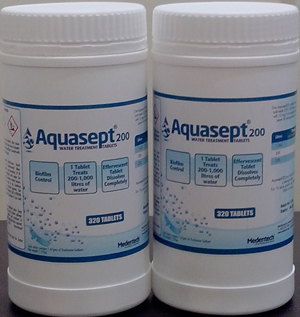Aquasept
- Overview
Aquasept1000® are effervescent tablets for the disinfection of drinking water for livestock. The active ingredient in Aquasept® is Sodium Troclosene (NaDCC). Each tablet will deliver 5 mg/l of available chlorine when dissolved in 1,000 litres of water. - Presentation
Aquasept1000® are 17.3g finished weight tablets containing 8.68g of Sodium Troclosene, packaged in plastic tubs of 60 and 500 tablets with a shelf-life of 3 years. - Label Claims
Aquasept1000® is an effervescent tablet added to water for the management of disease in livestock.
- Directions for use and dosage
The method of administration can be varied to suit the water supply system, as follows:- Small volume disinfection: Simply add the required number of suitable tablets to a container to achieve the required concentration. After the recommended disinfection time the water is free of micro-organism and animals can drink the water.
- Central water supply with fixed water volume:
Simply add the required number of suitable tablets to your water tank/reservoir to achieve
the recommended concentration. After the recommended disinfection time the water is free
of micro-organism and can be brought on line. - Central water supply with flowing water:
Aquasept1000® can be used in conjunction with commonly used auto dosing systems based on a stock solution of up to 2000 ppm injected into flowing water. 4 tablets of Aquasept1000® in 10 litre water equals to 2000 ppm. To achieve an in-use target dosage of 5 ppm Sodium Troclosene you simply adjust the injection rate to 1 litre solution in 400 litre water. This will ensure that animal housing areas get a constant supply of safe potable water. Alternatively the residual chlorine at the 'end drinking point' in the pipeline can be measured using Free Chlorine Test Strips and the autodosing equipment adjusted to achieve a proper residual chlorine level. This ensures maximum biosecurity.
- 5. Validations and Field Trials
In validating the effectiveness of the product, Medentech has taken the basic criteria from the World Health Organization Guidelines for Drinking-Water Quality for human consumption. In summary, water quality standards should ensure:
No faecal (E. coli or thermotolerant), coliform counts in a 100ml sample
No total coliform counts in a 100ml sample.
Where chlorination is used to produce safe water there should be:
- a residual concentration of free chlorine > 0.5 mgs/litre (p.p.m.)
- but not greater than 5mgs/litre (p.p.m.)
